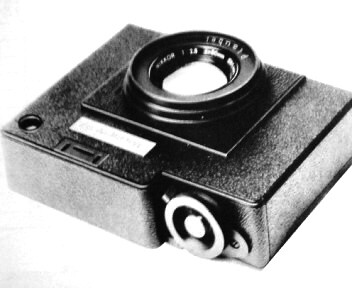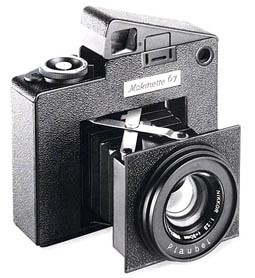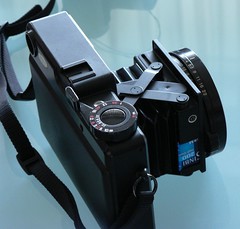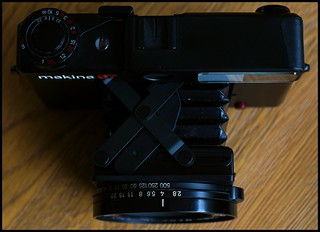Makina 67
The Makina 67 is a 6×7 strut folding camera with a coupled rangefinder. It was developed by Plaubel after the company was bought in 1975 by a Japanese company named Doi.
Contents
Development and production
Makinette 67
The Makina 67 was first shown as a prototype "Makinette 67" at Photokina 1976, quite different from the production model. The most striking functional difference is the patented viewfinder (US 4166682 A), which would pop up when the lens was pulled out to the infinity setting, and fold into the camera body when the lens was retracted. The purpose was to minimize the dimensions of the camera in the folded state, while providing an unobstructed viewfinder. In the end this concept was not used, making the final design noticeably wider. Further patents were applied for by Goetz Schrader (the previous Plaubel owner, and CEO until 1984) in september 1976, in time for the Photokina launch. This includes the scissor linkage (US 4171891 A), shutter release (US 4166686 A) and adjusting and latching mechanism (US 4146320 A).

|
| Plaubel Makinette 6x7 prototype closed image by Plaubel (Image rights) |

|
| Plaubel Makinette 6x7 prototype open image by Plaubel (Image rights) |
Plaubel Makina 67
Doi requested a redesign by professor Udo M. Geissler at the FH Munich (a colleague of Norbert Schlagheck of Schlagheck & Schultes), while parts of the final design were by Konica [1]. The chief Konica designer Yasuo Uchida stated that he had to fight with a "professor in Munich" (probably Geissler) over the size of the lens face. Uchida yielded in the end, and now considerds the big flat lens design one of the Makina 67's best distinguishing features[2]. The final Makina 67 was first shown at Photokina 1978, and was released in 1979. The camera's shape is reminiscent of the Makinette 6x7 prototype, but also the earlier Makina. After the redesign it also closely resembles the Agfa Optima Sensor Series, where professor Geissler or his colleague Norbert Schlagheck seems to have provided the design.
The production Makina 67 bodies were made in Japan by Konica. They have a Nikkor 80/2.8 lens.
Further development
The Makina W67 followed, announced at the 1981 PMA, with a specially designed Nikkor 55/4.5 wide angle lens and some changes to the design including a ribbed body, rubber ring on the focusing dial, smaller front face and a rectangular rangefinder window instead of round. The changes arguably meant that some of the original design signature of the Makina 67 was lost. The new body features were later used for an update of the original camera, now called the Makina 670, however the large front face was kept for the 80mm lens version.
At the 1982 Photokina Plaubel showed a prototype of a Makina Instant camera using instant-film packs, based on the Makina 67 and 67W. It had a simpler 90mm f3.5 lens with 4 elements in 3 groups, a Copal shutter, rangefinder focusing and built in exposure meter[3]. It seems never to have gone beyond the prototype stage.

|
| Plaubel Makina W67 wide-angle model image by Stefan Kellner (Image rights) |

|
| Combined focus knob, shutter release, winder image by peta-W (Image rights) |
Notes
- ↑ http://nikomat.org/priv/camera/mednikkor/makina/makina-e.html
- ↑ https://www.instagram.com/p/BJx-R8oBMj2/
- ↑ Popular Photography jan 1983 p. 102
Bibliography
- Lewis, Gordon, ed. The History of the Japanese Camera. Rochester, N.Y.: George Eastman House, International Museum of Photography & Film, 1991. ISBN 0-935398-17-1 (paper), 0-935398-16-3 (hard). P. 154.
- McKeown, James M. and Joan C. McKeown's Price Guide to Antique and Classic Cameras, 12th Edition, 2005-2006. USA, Centennial Photo Service, 2004. ISBN 0-931838-40-1 (hardcover). ISBN 0-931838-41-X (softcover). P. 789.
- Sugiyama, Kōichi (杉山浩一); Naoi, Hiroaki (直井浩明); Bullock, John R. The Collector's Guide to Japanese Cameras. 国産カメラ図鑑 (Kokusan kamera zukan). Tokyo: Asahi Sonorama, 1985. ISBN 4-257-03187-5. Items 1397–8 and 1400.
Links
In English:
- Makina 67 (also in Japanese) in Hiura Shinsaku's camera site
- Makina 67 and sales brochure in Ken Rockwell's website
- Makina 67 review by Rob Gardiner
- Makina 67 (brief summary and archived bulletin-board discussions) at an archived version of Robert Monaghan's Medium Format Photography website, at the Internet Archive.
In French:
In Japanese:
